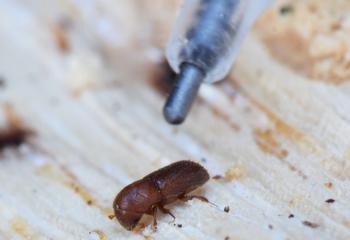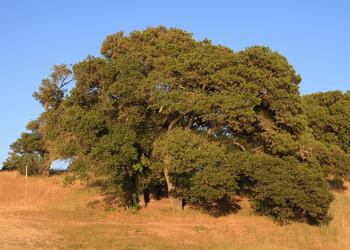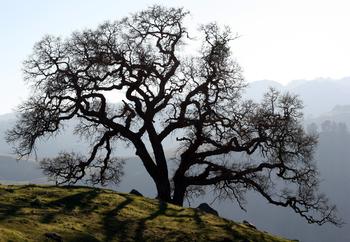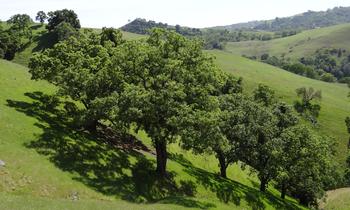Mediterranean oak borer
-
Steven Swain and Barbara Robertson
-
Recently, a wave of exotic pests and pathogens have poured into California. Some have the potential to be as destructive as the famous 20th-century tree plagues like Dutch elm disease and sudden oak death. One pest, the Mediterranean oak borer (MOB), an ambrosia beetle, is close to Marin.
 Ambrosia beetles like the Mediterranean Oak Borer are only a few millimeters long but their size belies their capacity for destruction. Curtis Ewing
Ambrosia beetles like the Mediterranean Oak Borer are only a few millimeters long but their size belies their capacity for destruction. Curtis EwingAmbrosia beetles like MOB are only a few millimeters long but their size belies their capacity for destruction. They don’t eat trees. They use trees like farm fields or veggie gardens. They bore tunnels into trees and sow fungi into these rows of tunnels. The fungi digest the trees, and the beetles eat the growing fungi. MOB’s favorite trees are the majestic valley oaks (Quercus lobata).
Valley oak, one of North America’s largest oaks, was once one of the most widely distributed in California. As its name implies, it grows best in deep, rich alluvial soils like those in river valleys. Soils that are also prime farmland. Huge numbers of valley oaks have been felled for farmland since the 1800’s. Even so, iconic trees still stand in vineyards and farm fields in Chico, Napa, Sonoma, San Rafael, Ojai, and beyond.
These are the MOB targets. First discovered in Napa County around 2018, MOB spread into Sonoma and Sacramento Counties in 2019 and 2020. Now, it’s moved west to the US 101 corridor around Windsor and Healdsburg, and south to Cotati. Maybe further. There are no known infestations in Marin County, but it’s time to be watchful. MOB Beetles prefer large, stressed valley oak trees. They rarely attack those with trunks less than six inches in diameter. Photo: King of Hearts
MOB Beetles prefer large, stressed valley oak trees. They rarely attack those with trunks less than six inches in diameter. Photo: King of HeartsLook for these symptoms: MOB prefers large, stressed trees; it rarely attacks trees with trunks less than six inches in diameter. Trees dying from MOB typically have a thin upper canopy, but with some leaves hanging on (unlike leafless limbs of drought-stressed trees.) This is because a MOB-infested tree often dies so quickly leaves don’t have time to form abscission zones (the scar tissue on a branch that lets leaves drop easily). Beetles tunnelling in the large branches cut off water to the smaller branches in the upper canopy then move down into the main trunk killing the tree. Symptoms in early summer often include clumps of tiny leaves that never fully flush out. Other maladies can produce these symptoms; however, MOB tunnels in cut wood are distinctive.
Unfortunately, no curative treatments have yet been effective against MOB and its fungus. The beetles plant the fungus deeper into the wood than fungicides can reach. Systemic insecticides do little since beetles don’t eat the tree, they just bore into it. And topical insecticides would have to be applied to all sides of all of every branch greater than four inches in diameter to be effective, a daunting prospect for a mature valley oak. MOB-infected valley oak trees will have clumps of tiny leaves in early summer that never fully flush out. Photo: Philip Bouchard
MOB-infected valley oak trees will have clumps of tiny leaves in early summer that never fully flush out. Photo: Philip BouchardThere are still many large, old valley oaks in Napa and northern Sonoma County, so the presence of the beetle is not a death sentence for every tree, though. Currently, the best approach to save valley oak trees is prevention.
When MOB was first recorded in Napa County, it followed a period of low rainfall, and the beetle seemed to spread rapidly. When the next few years brought adequate rain, the incidence of valley oaks attacked by MOB was vanishingly low. Then, it seems likely that the drought of 2021-2022 fueled the beetle’s recent expansion, allowing the pest to colonize trees that otherwise might have withstood their attacks. Most surviving trees had access to summer water.
Thus, we’re left with this conclusion: The best way to prevent a MOB attack is to give oak trees enough water during drought years. Valley oak trees, once the most widely distributed trees in California, are threatened with destruction by a tiny beetle. Photo: Belinda Lo
Valley oak trees, once the most widely distributed trees in California, are threatened with destruction by a tiny beetle. Photo: Belinda LoAs a rule, mature oaks don’t like summer water, especially routine summer irrigation, but they can die of drought. In drought years, providing oaks with a deep watering once per month should be enough to give them the water they need without keeping their roots so constantly moist that they develop root rot. And that might be enough to keep MOB at bay.




